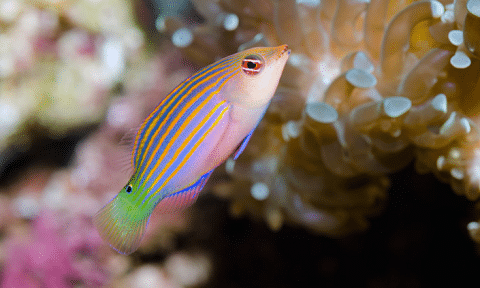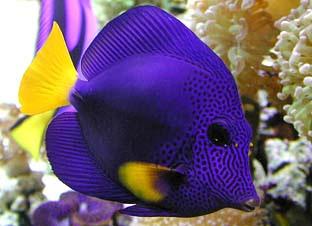Thank you for visiting! By the way… any links on this page that lead to products on Amazon and other stores/partners are affiliate links Aquarium Store Depot earns a commission if you make a purchase.
The Six Line Wrasse is a fantastic yet misunderstood fish. It is known for its unique coloration and interesting behavior. It is also known for its aggression in a community tank. In this blog post, we will discuss everything you need to know about caring for your own six line wrasse! These are great fish. It’s a shame to see them given away because they become too aggressive.
This guide includes the origins of the fish, behavior, and how to properly introduce them to the tank. Don’t be turned away by the horror stories. I’m here to guide you. Let’s dive into how to care for it!
Species Overview
| Scientific Name | Pseudocheilinus hexataenia |
| Common Names | Six line wrasse and six stripe wrasse |
| Family | Labridae |
| Origin | Indo-Pacific and the Red Sea |
| Diet | Omnivore |
| Colors | Purplish-pink, blue, yellow, orange, green |
| Care Level | Easy |
| Temperaturement | Semi-aggressive to Aggressive |
| Minimum Tank Size | 40 Gallons |
| Max Size | 3 inches |
| Temperature Range | 76 – 82 degrees F |
| pH Range | 8.0 – 8.4 |
| Salinity | 1.025 or 35 PPT |
| Reef Safe | Yes |
Origins And Habitat
Six line wrasses are a widespread species found throughout the Red Sea and Indo-Pacific. More specifically, they can be found in warm waters all the way from the west coast of southern African, up to the coasts of India, across to Japan, and down to Fiji; they can be found near surrounding islands as well1.
These attractive fish are found in shallow reefs no deeper than about 65 feet. They especially favor dense reefs with close-knit branched corals where they can easily hide and forage for small crustaceans.
Though six line wrasses are not very social, they may sometimes be seen in mating pairs or loose shoals as they forage the reef for food.
How Long Do They Live?
There is no average lifespan for six line wrasses, but it’s safe to say that they have the possibility to live 10 years or more.
In general, six line wrasses are incredibly hardy fish once established in the reef aquarium. There can be some difficulty with stress from improper care or poor acclimation, but these fish do extremely well once settled in.
What Do They Look Like?

Six line wrasses are very colorful and active fish. They are also very small, staying under 3 inches when fully mature, which can make them appealing to hobbyists with nano tanks. As we’ll discuss later, even though this fish is small it is by no means an appropriate nano species.
These fish have beautiful colors and patterns. They have a purplish-pink base color that can sometimes appear as dark red in different settings; the underbelly is usually the lightest portion of the body and can have a tan appearance against the bluish anal and ventral fins. In shape, the body is very aerodynamic with exact curvature for quick and efficient travel.
Six line wrasses are named after the six alternating blue and orangey-yellow stripes along the sides of their body that run from behind the gill, onto the dorsal fin, and onto the caudal (tail) fin. The tail fin can be green at the base and transition into yellow or become transparent. At the top of the base of the tail, there is also a black eyespot which can be used to confuse predators.
Six line wrasses also have very characteristic red eyes with two horizontal stripes at either side of the pupil.
Hermaphroditism
While six line wrasses have not been successfully bred on a large scale in the aquarium hobby, their reproductive habits and life stages have been closely studied.
Like many other species of wrasse, the six line wrasse is a protogynous hermaphrodite. This means that the individual fish are born as females and transition into males as they mature in response to internal and external factors.
This is very unlikely to happen in the aquarium setting which is a closed system without additional environmental factors.
Tank Requirements
There is a lot of debate surrounding six line wrasse tank and care requirements. For many years, they were eagerly shoved into small tanks due to their small size. However, over the past few years, hobbyists have generally agreed that they need a lot more space than was originally believed.
Still, some hobbyists have had success keeping six line wrasses in 20 gallons. Other hobbyists find that 55 gallons is the bare minimum. We believe that a standard 40 gallon fish tank with intricate rockwork should be enough space for your six line wrasse to freely roam.
As they heavily rely on the structure of reefs and corals in the wild, live rocks are a necessity for this species. It is also recommended to use a sand substrate as six line wrasses, like many other species of wrasse, will use the sandbed to hide if stressed. Some will even sleep in the sandbed, though this is usually a sign that something else is wrong in the tank.
Otherwise, six line wrasses are incredibly hardy. They can be a little tricky to acclimate and don’t do well with sudden changes in water parameters but will thrive once established. There is no special care or maintenance needed to make sure your six line wrasse does well once introduced into the aquarium.
However, it is also a necessity to have a tight-fitting lid on the tank. Remember, these fish are aerodynamic and can easily jump out of small openings in the top of the aquarium. If you have a rimless aquarium, consider getting a mesh net to prevent your fish from jumping.
Temperament
Not only are six line wrasses known for their activity levels, but they can also be very big bullies. There are a few benefits to having them in the tank though as they can sometimes act as a type of cleaner fish and will even control some pest populations (Video source).
Six line wrasses are often the most active fish in any aquarium setup. They can quickly dash across the front of the reef tank or take their time maneuvering in and out of the rocks, looking for some microorganism to nibble on. No matter what they’re doing, they’re always moving.
However, when they’re not looking for food they might be bothering other fish. There are many stories from hobbyists who have had to trade in or give away their six line wrasse after a year of having them because they turn into a menace overnight. This is one of the risks you take when adding one of these fish to your aquarium!
Six line wrasses are generally labeled as being semi-aggressive, though they’re usually either peaceful or aggressive with no in-between. The problem with these fish is that they can be model citizens until they’re not. One day, they may start terrorizing other peaceful fish in the aquarium and they won’t stop; six line wrasses are very persistent at pestering other fish, which can quickly lead to weakened, sick, and dead tankmates.
As mentioned before, many hobbyists end up giving their six line wrasses away as the aggression only gets worse with time. However, increasing feedings and providing more hiding places may help deter some aggression, though this is not guaranteed.
If you’re looking for a fish that’s not as aggressive but still as colorful, then you may consider the eight line wrasse (Pseudocheilinus octotaenia); note that these fish are considerably larger and can also be relatively aggressive. Other larger peaceful wrasses like the Yellow Coris do not exhibit this behavior, but may harass and eat shrimp.
Are They Cleaner Fish?
It has been said that six line wrasses can act as a cleaning species for other fish, though this isn’t often observed. In general, a cleaner shrimp is going to do a better job.
Some hobbyists have seen their six line wrasse approach other fish and pick at parasites and other foreign bodies that might be present. While some wrasses, like the bluestreak cleaner wrasse (Labroides dimidiatus), are known for having a mutualistic cleaning relationship with fish, this behavior is largely undocumented with six lines.
If you find that your six line wrasse is picking at the sides of other fish in a friendly manner, then you may have a cleaner six line wrasse! Keep an eye out for if this turns into aggression and/or starts to bother the other fish.
Pest Control

Though your wrasse might not be a natural cleaner, there is a good chance that it will control some pests in your saltwater aquarium. Six line wrasses are foragers and advantageous scavengers. They will happily eat any small invertebrates they come across as they swim in and out of the rocks.
Some of the six line’s favorite quick snacks include flatworms and bristle worms. This can be beneficial for hobbyists struggling with flatworm or nudibranch hitchhikers, like those commonly found on small polyp stony (SPS) corals. They can also help hobbyists who don’t enjoy the appearance of bristle worms, though these worms can be some of the best cleanup crew members.
At the same time, six line wrasses will eagerly eat any copepods they come across. Hobbyists work years to establish a healthy copepod population in their aquariums, especially if they have a finicky eater like the mandarin goby (Synchiropus splendidus). If this applies to your tank, you should not add a six line wrasse.
It should also be said that six line wrasses will not eradicate a pest infestation. Though they will definitely help control populations, there are simply too many pests for one fish to eat. In addition, these fish should never be added to a tank simply to help with a pest problem!
Are They Reef-Safe?
Past their aggression and interesting behaviors, six line wrasses make a great reef-safe fish; of course, there will always be one individual that is not reef-safe from this sample, but in general, six line wrasses are reef-safe.
In fact, these fish feel especially at home in between the branches of elaborate SPS colonies. In the wild, they use these branches for protection and this natural behavior will translate into the saltwater aquarium setting as well.
Tankmates

Six line wrasses are largely regarded as a community species fit for any fish only (FO), fish only with live rock (FOWLR), or reef setup. However, they shouldn’t be treated as just another community fish.
In general, you want tankmates that can stand against your six line wrasse, either in terms of speed or aggression. Species like tangs, angelfish, and damsels, will be able to escape or hold their own against the tyranny of an aggressive six line wrasse.
There are a few methods to increase the chances of compatibility among your tankmates.
- Add the six line wrasse last. Adding this species to the tank last leaves little room for a hierarchy to form among other fish and even less physical space for a large territory to be established.
- Acclimate slowly. In this case, we don’t mean acclimation in the sense of matching water parameters. Instead, use a glass or plastic container to slowly introduce your wrasse to the rest of the tankmates. Simply submerge or float this container with your wrasse inside for several days. This should get all fish familiarized with each other so there is less immediate aggression.
- Get a pair of six line wrasse. Pairs of wrasses are difficult to come by. This method only really works if you know with certainty that the two fish are already a mated pair. Some hobbyists have found that keeping six line wrasses in pairs completely diminishes aggression.
Lastly, you want to stock your tank accordingly. There are definitely a few species you will want to avoid if you’re trying to eventually add a six line wrasse to the stock list.
Can They Live With Clownfish?
Whether or not six line wrasses can live with clownfish is completely up to the personality of the individual fish. I, personally, kept a six line wrasse with ocellaris clowns (Amphiprion ocellaris) and never had a problem. Other hobbyists have had their clownfish killed overnight.
If you desperately want to keep your clownfish alive, then do not add a six line wrasse. There are also a few other species of clown that might be able to tolerate possible aggression instead.
Some varieties of maroon clown (Premnas biaculeatus) can grow to be very large, which could possibly intimidate the wrasse. Tomato clowns (Amphiprion frenatus) can also get to be very big and are one of the most aggressive species, making them a good candidate as a six line wrasse tankmate.
Can They Live Together?
Yes, some hobbyists have successfully kept pairs of six line wrasse together, though this is rare. In fact, pairs often help diffuse aggression.
More importantly, though, wrasses of different species should not be kept with six lines. It is not unheard of for a six line wrasse to kill another, larger species of wrasse. The territories, body shapes, and behaviors can overlap too much and the six line may see the other fish as a threat.
Of course, some hobbyists have had complete success keeping an assortment of wrasses together, though this is uncommon.
What Do They Eat?
Six line wrasses are very opportunistic feeders. On top of the many bristle worms, snails, and microorganisms they find among the rocks, they will readily eat fish flakes and pellets. They will also appreciate meaty foods like live, frozen, and freeze-dried options like brine shrimp and mysis shrimp as well. Blackworms are also a good option. For frozen foods, I highly recommend LRS foods.
Will They Eat Peppermint Shrimp?
While these fish gladly eat small invertebrates, they generally leave bigger snails, crabs, and shrimp alone. This includes peppermint shrimp (Lysmata wurdemanni) that are much larger than the very small mouth of the six line wrasse.
Of course, if your fish is especially hungry, it might try to go after bigger prey and it’s not unheard of for them to eat snails and smaller shrimp. As long as you keep your fish fed and watch for signs of aggression, there should be no problems with keeping other invertebrates.
Final Thoughts
Six line wrasse have been misunderstood for a very long time. Just recently, hobbyists have come to understand their true needs and aggression levels. Though these fish are relatively peaceful and reef-safe, they definitely have the capability of attacking and killing other fish in the tank.
Keeping aggression in mind, these popular saltwater aquarium fish bring color to the home display like no other and are exceptionally hardy once established in the tank.
- About the Author
- Latest Posts
I’m thrilled that you found Aquarium Store Depot! Here you’ll find information on fish, aquariums, and all things aquatics related. I’m a hobbyist (being doing this since I was 11) and here to help other hobbyists thrive with their aquariums! I adhere to a high quality Editorial Process and Review products with real life field usage and practical analysis.





